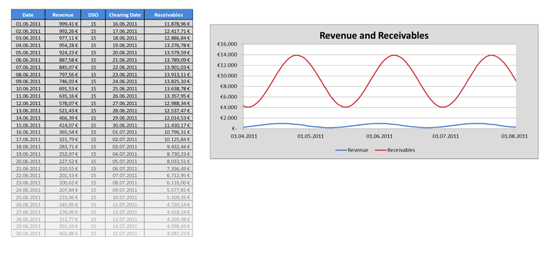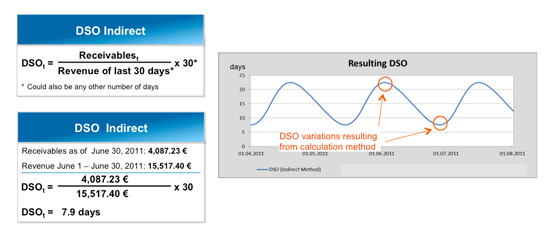Learn two common calculation methods that are available for analyzing key aspects of working capital. You should then be able to choose which of the calculation methods most suits your analysis and configure SAP Working Capital Analytics to use that method to investigate the drivers of your working capital.
Key Concept
SAP Working Capital Analytics is an analytical tool included in the SAP HANA Live license that helps companies analyze the drivers of two key components of working capital – days sales outstanding (DSO) and days payables outstanding (DPO) – and how these change over time.
Finance departments have to manage working capital so that they can keep their business operations running and still be able to flexibly support the strategic goals of their business. Working capital management and optimization are key tasks of every finance department. They have to ensure that they can maintain production, cover the cost of wages and supplies, and have enough liquidity on hand to service their short-term credit obligations.
At the same time, the CEO might have plans to expand the business or start a new investment project, which might need additional capital. The finance department weighs the accounts receivables and inventory (short-term or current assets) with the accounts payables (short-term or current liabilities) to determine if there is enough working capital available to support the strategic investment with internal money, or whether there is a gap in financing. Any gaps are likely to be filled by external capital – usually at a higher cost than internally available funding. Being able to accurately measure and manage working capital, and avoid expensive external financing, can provide companies with a competitive advantage.
The in-memory data analysis capabilities of SAP HANA allow large volumes of business transactions to be considered for a direct analysis of the drivers of working capital. This is fundamentally different than the indirect approach, which relies on financial reporting aggregates. SAP Working Capital Analytics allows companies to take both approaches. I explain the concepts behind the calculation logic and the type of effort required to switch between the logic alternatives in the tool.
Most Companies Use an Indirect Calculation Method Today
Despite the importance of accuracy in working capital measurement and management, most companies use an indirect measurement technique that is highly sensitive to distortion based on business cyclicality and reporting key dates. Let’s look closely at a common indirect calculation of days sales outstanding (DSO). Each day, a certain random amount of revenue is generated, with revenue always resulting in a corresponding accounts receivable position. The customers always pay after 15 days, which results in a DSO of 15 days (Figure 1).

Figure 1
A simulation example of revenue and receivables
In this example I apply a standard indirect calculation formula that looks at the receivables and revenues of the last 30 days. The results are shown in Figure 2. The number of days considered is arbitrary. I could have used a month, a quarter, or a year. Although I know from my simulation example that every invoice is paid after exactly 15 days, and thus the DSO should be 15 days, I see that the indirect approach results in significant variations of DSO values, depending on the point in time that the calculation is performed. For example, on June 3, the DSO is 19.3 days, whereas on June 30, the DSO is 7.9 days. Seasonal fluctuations further amplify this effect.

Figure 2
An example of indirect calculation
Some companies try to dampen the effects by using rolling averages to calculate DSO. This process does decrease variations to some degree, but there is still variation, and therefore these indirectly calculated DSO values are only approximations of business performance.
Despite these imperfections in accuracy, however, there are some reasons why companies continue to use the indirect method. First, the cost of using this calculation logic is very low. These reporting figures of revenue and receivables balances are easily obtained and can generally be found in standard financial reports. Second, although the accuracy of the reported DSO key performance indicator (KPI) is likely imperfect, the data remains comparable on a year-over-year basis, provided there were not significant shifts in the makeup of the business. Accounts receivable departments or finance teams might be measured on DSO or improvements in DSO by their managers for their own compensation. It is in their best interests to keep the reported numbers comparable, even if this means taking a loss of accuracy into account. In this case, any calculation logic change would need to keep the older logic in place, running in parallel, to ensure comparability during the period of time relevant for performance reviews.
The Direct Method Is Now Available
A direct calculation is now possible based on the analysis of potentially millions of individual business transactions using big data tools. (For more information read “Make Profitability Management More Proactive with the SAP CO-PA Accelerator.”)
The direct calculation of DSO is based on original documents, reflecting individual business transactions. The period of time between posting an invoice (posting date) and receiving payment for the invoice (clearing date) is calculated for the relevant document line item to provide the most accurate results possible. These calculations, based on details of each document, help to derive DSO values that reflect the true nature of the business. Figure 3 indicates that I indeed did arrive at a DSO of exactly 15 days.

Figure 3
Direct calculation
Depending on the particular processes of the business, there is still some inaccuracy, even with the direct calculation. For example, in countries in which there are significant up-front payments or industries with large rates of product returns, the business documents may not support this method. Although exceptions in some business transactions mean that the direct calculation is still not absolutely perfect, the improvement in accuracy and the availability of drill down and filtering make it a very interesting alternative for financial analysts to consider.
Introduction to SAP Working Capital Analytics
SAP Working Capital Analytics was designed for users who want to understand how different groups of customers and suppliers, different payment behavior in different countries, or terms and conditions arranged with suppliers, have an impact on working capital. These users may be part of the controlling group or they could be financial analysts in the business. The application encourages users through its many filtering and reporting views to get intimately familiar with the data – without needing advanced data modeling skills.
After choosing the company codes and currency/exchange rates that should be used in the analysis, the user can move from aggregated data down to the details of individual transactions. There are a large number of analysis steps (reporting views) delivered with the tool that can be added to the investigation. The user then can select a subset of the data displayed in the chart or graph by using the mouse to click on a particular bar or chart area. This filters the data set, and subsequent charts only reflect that subset of the data. These filters can be turned on or off flexibly, just as the reporting views can be reordered via drag and drop. The combination of data filters and analysis steps is called the analysis path. This analysis path can be saved and reused.
How to Switch to the Indirect Method in the Implementation Project
SAP Working Capital Analytics allows companies to choose which calculation logic they prefer to use for analyzing DSO and days payable outstanding (DPO). Both sets of the underlying HANA views (direct and indirect) are delivered with the standard analytical application. However, the user interface is delivered with the HANA views for the direct calculation logic linked to the graphical visualizations, while the HANA views for the indirect method are dormant.
Changing the configuration to switch from the direct to the indirect calculation logic usually has to be done by an IT expert, not a standard business user. The process takes around 20 minutes, and is generally something that would be done in the implementation phase of the SAP Working Capital Analytics application. (The total implementation time, given a system that already has HANA Live in place, has averaged three hours in early adopting customers to date.)
To change to the indirect method (for DSO), complete these steps:
- Open the analytical content configuration file (in Notepad or any text editor)
- Search for all request objects with entity type WCADaysSalesOutstandingQuery or WCADSORevenueQuery
- If the selectProperties section of the request object contains the property YearMonth, replace the entity type with WCAIndirectDSOHistoryQuery.?In all other cases, replace the entity type with WCAIndirectDSOQuery.
To change to the indirect method for DPO, complete these steps:
- Open the analytical content configuration file (in Notepad or any text editor)
- Search for all request objects with entity type WCADaysPayablesOutstandingQuery or WCADPOExpenseQuery.
- If the selectProperties section of the request object contains the property YearMonth, replace the entity type with WCAIndirectDPOHistoryQuery. In all other cases, replace the entity type with WCAIndirectDPOQuery.
Although the find-and-replace method of making this change is a bit tedious, it remains a one-time investment. It is also possible to configure the application to offer both indirect and direct calculation methods. This would entail duplicating the HANA views. You would also need to adjust the naming of the graphics to note whether they are linked to direct or indirect calculation logic so that the end user is aware of the underlying logic.
Note
SAP Working Capital Analytics is available with Business Suite on HANA, in a sidecar scenario, and also with the Financials Add-on for Business Suite on HANA.
Katharina Reichert
Katharina Reichert is part of the Finance Solutions team at SAP SE, located in Walldorf, Germany. As the solution owner for receivables management, she focuses on applications for customer credit management, customer billing, dispute resolution, and collections management.
You may contact the author at katharina.reichert@sap.com.
If you have comments about this article or publication, or would like to submit an article idea, please contact the editor.







